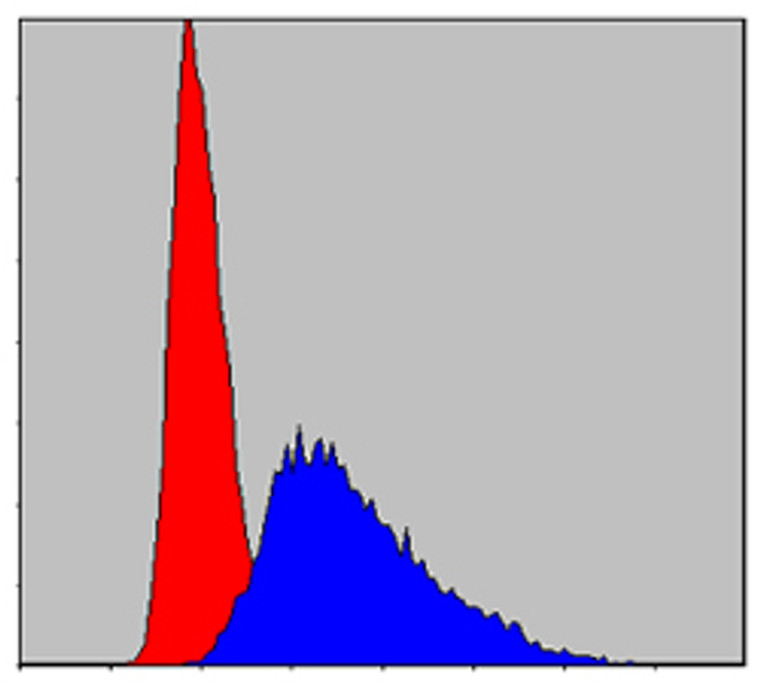| Host: |
Mouse |
| Applications: |
WB/IF/FC/ELISA |
| Reactivity: |
Human |
| Note: |
STRICTLY FOR FURTHER SCIENTIFIC RESEARCH USE ONLY (RUO). MUST NOT TO BE USED IN DIAGNOSTIC OR THERAPEUTIC APPLICATIONS. |
| Short Description: |
Mouse monoclonal antibody anti-Tyrosine-protein kinase ITK/TSK is suitable for use in Western Blot, Immunofluorescence, Flow Cytometry and ELISA research applications. |
| Clonality: |
Monoclonal |
| Clone ID: |
5G6 |
| Conjugation: |
Unconjugated |
| Isotype: |
IgG1 |
| Formulation: |
Liquid in PBS containing 0.03% Sodium Azide, 0.5% BSA, 50% Glycerol. |
| Purification: |
Affinity purification |
| Dilution Range: |
WB 1:500-1:2000IF 1:200-1:1000FC 1:200-1:400ELISA 1:10000 |
| Storage Instruction: |
Store at-20°C for up to 1 year from the date of receipt, and avoid repeat freeze-thaw cycles. |
| Gene Symbol: |
ITK |
| Gene ID: |
3702 |
| Uniprot ID: |
ITK_HUMAN |
| Specificity: |
Emt Monoclonal Antibody detects endogenous levels of Emt protein. |
| Immunogen: |
Purified recombinant fragment of human Emt expressed in E. Coli. |
| Post Translational Modifications | Phosphorylated at Tyr-512 in the activation loop of the kinase domain by LCK. Subsequent autophosphorylation at Tyr-180 leads to the kinase activation. The autophosphorylated Tyr-180 lies within the substrate binding sequence of the SH3 domain. Ubiquitinated. |
| Function | Tyrosine kinase that plays an essential role in regulation of the adaptive immune response. Regulates the development, function and differentiation of conventional T-cells and nonconventional NKT-cells. When antigen presenting cells (APC) activate T-cell receptor (TCR), a series of phosphorylation lead to the recruitment of ITK to the cell membrane, in the vicinity of the stimulated TCR receptor, where it is phosphorylated by LCK. Phosphorylation leads to ITK autophosphorylation and full activation. Once activated, phosphorylates PLCG1, leading to the activation of this lipase and subsequent cleavage of its substrates. In turn, the endoplasmic reticulum releases calcium in the cytoplasm and the nuclear activator of activated T-cells (NFAT) translocates into the nucleus to perform its transcriptional duty. Phosphorylates 2 essential adapter proteins: the linker for activation of T-cells/LAT protein and LCP2. Then, a large number of signaling molecules such as VAV1 are recruited and ultimately lead to lymphokine production, T-cell proliferation and differentiation. Required for TCR-mediated calcium response in gamma-delta T-cells, may also be involved in the modulation of the transcriptomic signature in the Vgamma2-positive subset of immature gamma-delta T-cells. Phosphorylates TBX21 at 'Tyr-530' and mediates its interaction with GATA3. |
| Protein Name | Tyrosine-Protein Kinase Itk/TskInterleukin-2-Inducible T-Cell KinaseIl-2-Inducible T-Cell KinaseKinase EmtT-Cell-Specific KinaseTyrosine-Protein Kinase Lyk |
| Database Links | Reactome: R-HSA-202433Reactome: R-HSA-2871809 |
| Cellular Localisation | CytoplasmNucleusLocalizes In The Vicinity Of Cell Surface Receptors In The Plasma Membrane After Receptor Stimulation |
| Alternative Antibody Names | Anti-Tyrosine-Protein Kinase Itk/Tsk antibodyAnti-Interleukin-2-Inducible T-Cell Kinase antibodyAnti-Il-2-Inducible T-Cell Kinase antibodyAnti-Kinase Emt antibodyAnti-T-Cell-Specific Kinase antibodyAnti-Tyrosine-Protein Kinase Lyk antibodyAnti-ITK antibodyAnti-EMT antibodyAnti-LYK antibody |
Information sourced from Uniprot.org
12 months for antibodies. 6 months for ELISA Kits. Please see website T&Cs for further guidance

![Anti-ITK antibody [5G6] (STJ98020)](https://cdn11.bigcommerce.com/s-zso2xnchw9/images/stencil/760x760/products/120169/229765/STJ98020_4_ELISA__88313.1602854497.jpg?c=1)








